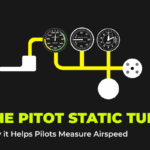Pilots, even seasoned ones, can be surprised by the airplane’s nose turning the wrong way when initiating a roll. This phenomenon is called adverse yaw, and it’s critical to understand and manage for smooth, safe, and efficient flight.
1. What Is Adverse Yaw and Why Does It Happen?
Adverse yaw is the tendency of an aircraft to yaw (nose turn) in the opposite direction of the roll. For instance, rolling to the right initially causes the nose to swing left.
This occurs because the ailerons induce unequal lift and drag:
- Das down-going aileron increases lift and induced drag on that wing.
- Das up-going aileron reduces lift and drag on the opposite wing.
- This imbalance causes the plane’s nose to yaw toward the wing generating more drag i.e., opposite the intended turn.
Moreover, the rolling motion itself shifts the lift vector of the wings, further contributing to adverse yaw.
“The drag that leads to adverse yaw is primarily induced drag… when you create ADDITIONAL lift to elevate one wing, you create ADDITIONAL drag on that side.”
2. Why It Matters
- Safety: At low speeds like during approach or base leg a slip or uncoordinated turn can result in a stall, potentially leading to a spin.
- Efficiency: Uncoordinated turns increase drag and reduce aerodynamic efficiency.
- Comfort: Coordinated flight avoids sudden yawing forces, making the experience more comfortable for pilots and passengers.
3. How to Counter Adverse Yaw
- Rudder Coordination: Apply rudder in the same direction as the turn to keep the nose aligned with the flight path. Use the slip indicator (“ball”) or turn coordinator to ensure proper coordination.
- Feel and Training: Practice “rolling on a heading” roll while keeping heading constant using synchronized rudder and aileron inputs.
4. Aircraft Design Solutions
Several design features help mitigate adverse yaw:
| Design Feature | How It Helps |
|---|---|
| Differential Ailerons | The up-going aileron moves more than the down-going one, increasing drag on the descending wing and reducing adverse yaw. |
| Frise Ailerons | When up aileron is deflected, its leading edge protrudes into airflow, creating drag on the wing that balances yaw. |
| Roll Spoilers / Spoilerons | On larger aircraft, spoilers increase drag on the descending wing to reduce yaw, used where rudder alone isn’t sufficient. |
| Fly-by-Wire Aileron-Rudder Mixing | Modern systems can automatically apply coordinated rudder based on aileron input, enhancing handling in all regimes. |
Summary
- Adverse yaw happens because of asymmetric lift and drag during a roll.
- It’s most pronounced at low speeds and in aircraft with long wings.
- Counter it with proper rudder input, coordinated control, and awareness of aircraft-specific behavior.
- Design features like differential or Frise ailerons and advanced control systems mitigate the effect.
Understanding adverse yaw isn’t just textbook it’s a core piloting skill that improves safety, efficiency, and the overall feel of the aircraft. Keep practicing coordinated turns, trust the “ball,” and let aerodynamic principles guide you in the skies.



